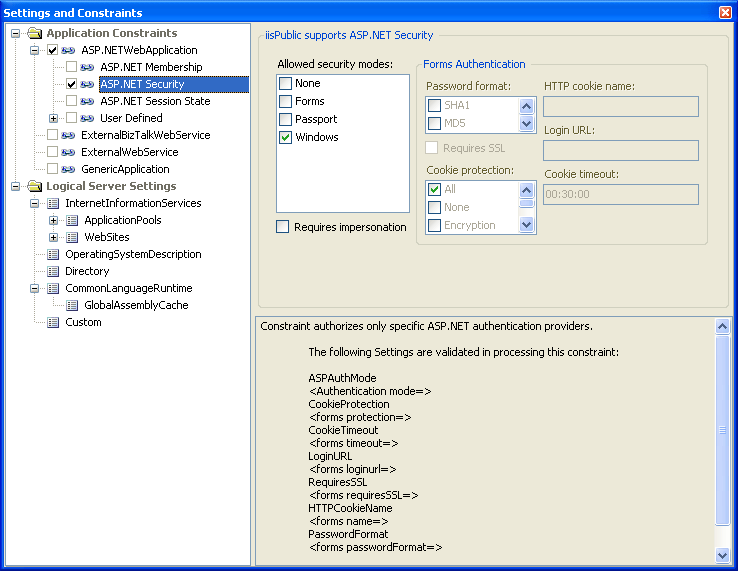Settings and Constraints
Settings and Constraints
Almost every Host and application placed on a logical datacenter diagram, an application diagram, or a system diagram can have settings and constraints configured. Constraints define requirements that must be satisfied during deployment. For example, a constraint can be set on an application, which dictates the logical server onto which it can be hosted. Servers in a logical datacenter diagram can be restricted in many ways to properly model the policies that exist in that datacenter. A constraint might require or restrict certain types of communication. Examples include requiring specific security aspects or barring a certain application type altogether.
There are three primary types of constraints:
- Implicit
Based on the element being used
Example—IIS Servers intrinsically allow only certain file extension mappings. For example, if the .soap script map were removed from the Web server, the Web service bound to a Web site would not be supported. Implicit constraints are the same as built-in constraints in that there is no user interaction required to enable and fire the constraint. Other examples include securing of ASP.NET applications to be compatible with IIS settings.
- Predefined
As defined by the designer
Example—A constraint controls whether an ASP.NET application can be hosted on a specific Host.
- User-defined
Created by authoring one or more settings to form a constraint
Example—Only ASP.NET Web services built by the user named Cory can be hosted on a specific Host.
NOTE
New constraints can be authored with the SDK.
Logical server constraints can also advertise the capabilities of the server. Predefined constraints can be used to specify the operating system and the .NET Framework versions available on a server. A server can be constrained so that certain application types are not permitted to deploy. Other constraints might specify that a specific feature of an application is required, such as specifying that only the ASP.NET SqlProvider be used for Role and Membership in ASP.NET applications. All of this is important documentation, both for the team members and for Team System's designers. In other words it's important for architects, developers, and especially the IT professionals who will be deploying the application to understand configuration issues and to have a readable document. You will learn more about the deployment report later in this chapter.
NOTE
All constraints will be evaluated using the Deployment Designer, ensuring that the application can be properly hosted on the corresponding Host.
The Settings and Constraints Editor (shown in Figure 5-12) is used to define various element attributes included in each diagram: logical datacenter, application, and system. In other words, this is the same editor used by all of the Distributed System Designers. The Settings and Constraints Editor is normally docked below the bottom edge of the main designer. If it isn't visible, it can be displayed from any diagram element's context menu.

Figure 5-12 The Settings and Constraints Editor
EAN: 2147483647
Pages: 97